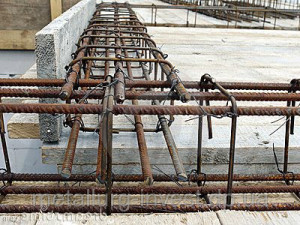It is not difficult to make a reinforcing cage for a strip foundation. It is worth studying the basic requirements for the reinforcement to be used and the technology of how to reinforce the strip foundation. Under all conditions, the finished frame will be strong and durable.
The strip foundation has a lot of advantages compared to other bases. It is suitable for the construction of foundations and multi-storey and single-level buildings on any type of soil. That is why he is so often used in individual construction. Knowing the basic principles of work, and following them exactly, with correctly performed calculations, you can easily build a foundation with your own hands.
During the operation of the building, sediment often appears. The soil under the sole of the base becomes denser. And the greater the pressure on the foundation, the faster this process occurs. If the calculations are performed correctly and the load is evenly distributed on the ground, then cracks and chips on the sides do not appear on the tape base. But in fact, the opposite often happens.
In this case, an inexperienced builder may encounter the problem of how to properly reinforce the strip foundation. After all, it depends on how long the building will be operated. Therefore, it is worth dwelling in more detail on the choice of material and the technological sequence itself.
When freezing, the soils swell and from this additional forces act on the foundation
Reinforcement selection
The strength of the frame depends on the choice of reinforcement.
Existstwo main types:
- steel (metal);
- composite (fiberglass)
The latter variety arose in the 50s of the last century, but did not find wide distribution in individual construction, despite the fact that it has a number of advantages compared to metal.
Steel reinforcement, in turn, can be:
- rod;
- wire.
For reinforcing work bar reinforcement of a periodic profile is used on a strip foundation, as a working (another name is longitudinal) and smooth (transverse) as an auxiliary.

Particular attention should be paid to the reinforcement of corners, because. these places are the most loaded.
In reinforcing corners, the following rules must be observed:
- the rods at the corners are bent so that their ends are deepened into the base wall with a minimum bypass of 40 cm (for rods with a diameter of 10 mm);
- places where they overlap each other must be strengthened with vertical and transverse rods;
- if the length of the bar is not enough to bend it onto the wall, then it is necessary to strengthen such places with L-shaped rods;
- clamps at the corners are connected with a step 2 times less.
Subject to these requirements, the corners will remain in their original form longer.
Reinforcing cage knitting
For tying reinforcement, a knitting wire with a diameter of 0.8-1.2 mm is used, which is cut into pieces of 10-20 cm. The minimum number of connections should be half the number of intersections.
In private housing construction, the reinforcement frame is often welded instead of knitting in order to speed up the process.
You can knit reinforcement in several ways:
- using pliers. To do this, the wire is folded in half, twisted and fixed with pliers with blunt teeth;
- you can use a hook and a screwdriver with a special nozzle. To do this, the pieces of wire are folded in half, hooked with a loop. The ends are wrapped at the intersection of the reinforcement, and then laid back into the hook. Then, turning the hook, rotate. You can use a screwdriver for these purposes;
- with the help of paper clips, clamps, staples, etc.;
- knitting gun.
The last method is considered the fastest and most effective. To do this, the nozzle of the gun is placed at the intersection of the reinforcement, and the knitting is completed with the tool.

The reinforcement of the foundation is considered to be correct if the following building rules:
- reinforcement of the base of the upper and lower surfaces;
- the longitudinal tiers of the frame are made of horizontally arranged rods connected with the help of transverse and vertical rods;
- working fittings are rods of class A3, the diameter of which is 10-16 mm, and the clamps for connection are made of fittings of class Vr-1 with a diameter of 4-5 mm;
- the frame is installed inside the base at a distance of at least 5 cm from its surface;
- longitudinal bars are installed in increments of 25 to 40 cm, and connecting clamps - 30 cm;
- the corners of the base of the reinforcement are laid with the formation of an overlap of 40 cm;
- the diameter of the wire for knitting is 0.8-1.2 mm;
- the minimum number of knittings is equal to half the number of intersections in the frame.
Under these conditions, the frame will turn out to be quite strong and stable. Experts recommend using specially designed tools for knitting. This will significantly reduce the time for knitting. If you do not have enough experience in this area, it is better to contact specialists.
For more information on how to make a reinforcing cage for a strip foundation with your own hands, you can watch the video:
